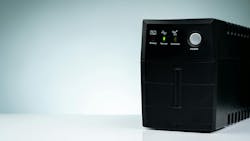The electric utility system is constantly subjected to minor voltage disturbances created by foreign objects brushing up against the power line conductors, the wind causing power line conductors to slap together, and nearby customers drawing in large startup current to cause a voltage sag. Voltage disturbances can also be created in a facility when air conditioners and microwaves turn on. The severity of these disturbances can be large enough to cause equipment to reset, misoperate, or even shutdown. Accumulated disturbances on- and off-site are enough to frustrate any maintenance personnel. So, how is a facility going to maintain its operations when it is constantly subjected to these minor voltage disturbances?
Uninterruptible power supply (UPS) systems come in different sizes, types, and with a variety of features. These systems store energy, typically in a battery, and then release that energy when needed. How much of that energy and how long that energy is provided depends on the amount of storage the UPS can handle and the load demand. Another aspect of a UPS system is the power conditioning qualities that these devices can provide. Manufacturers have included protection against surge, voltage swag/swell, undervoltage/overvoltage, harmonic distortion, conducted noise, and a complete loss of power. These protective features shield the electrical load from these disturbances and allow equipment to operate without any disruption.
You might think it’s best to install a UPS system on every piece of electrical equipment in a facility, but these devices require frequent inspection as the batteries can wear out over time and use. It’s best to strategically install a UPS on critical loads, as the typical recommendation for battery replacement is five years. Furthermore, as batteries are subjected to the environment’s temperature, constant charging and discharging cycles, and other factors, it’s possible the batteries will have a shorter life span.
Most UPS systems include a feature that allows you to test the batteries performance. It is recommended to incorporate the UPS batteries into the preventative maintenance cycle to ensure they are available when a power disturbance occurs. A telltale sign of the UPS degrading in performance is when a load, fed from the UPS, gradually begins to misoperate more frequently.
